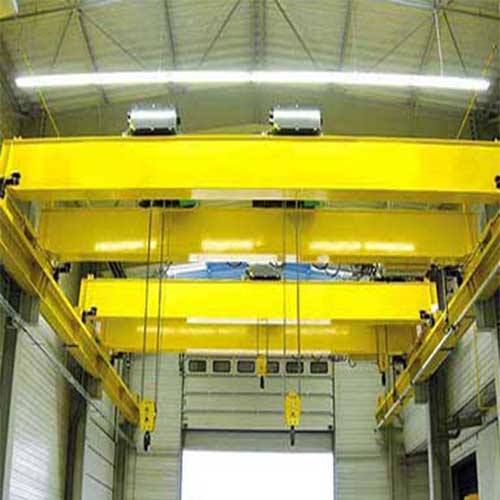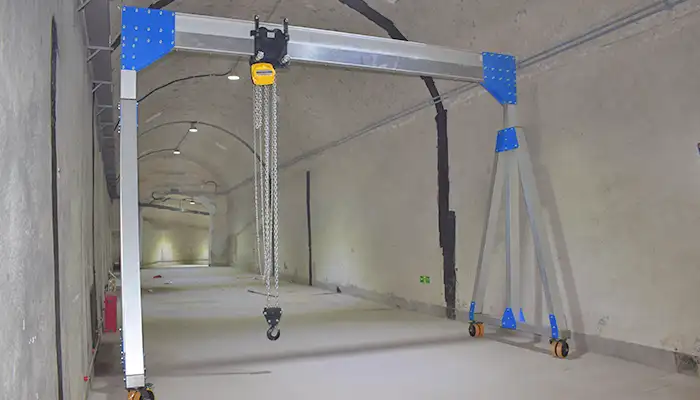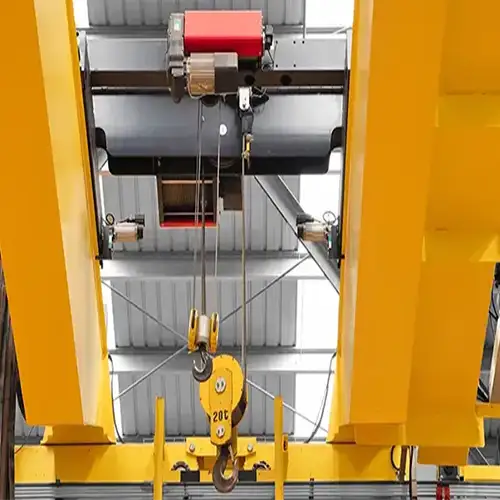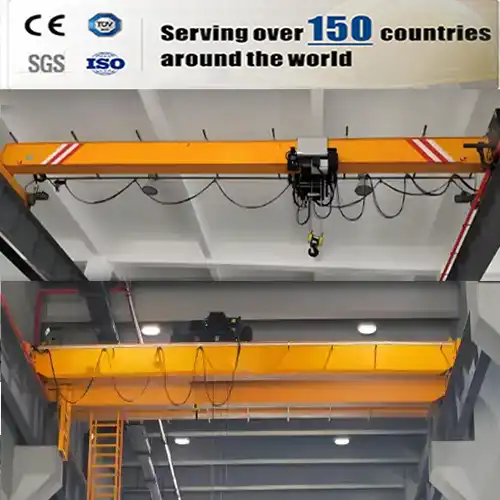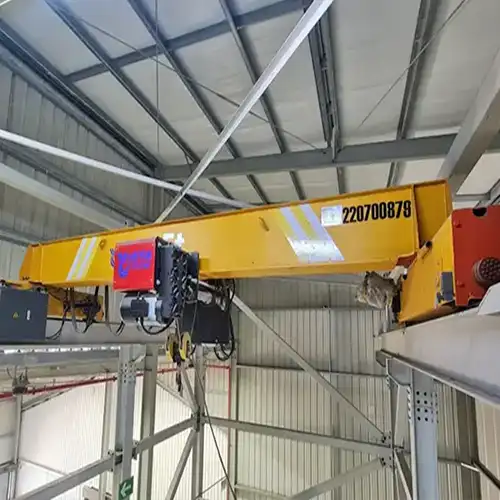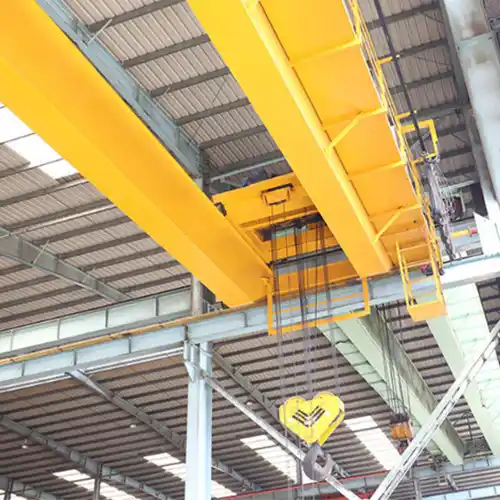Tandem lift of EOT Crane & Hoist, Tandem Crane & Tandem Hoist
Tandem lift of overhead cranes & electric hoists, synchronized operation of 2 or more hoists and cranes for handling long, large & heavy loads. Check now.
Category: Overhead Crane for Your Use
Tandem lift of EOT Crane & Hoist, Tandem Crane & Tandem Hoist
Tandem lift of overhead cranes & electric hoists, synchronized operation of 2 or more hoists and cranes for handling long, large & heavy loads. Check now.
For the safety and effectiveness of your operations, there are specific requirements when lifting long, bulky, awkward objects using an electric crane and electric hoist. Lifting these weights with two hoists, or tandem hoists, may be one approach. The other is to use two or more overhead travelling cranes to lift the loads. With two tandem cranes or tandem hoists, heavy, long products can be handled successfully. In order to lift and move at the same pace, the two electric hoists or two electric cranes must be synchronized. A long object can be lifted safely and with minimal product damage by using tandem cranes and hoists.
Your Trusted Overhead Crane Manufacturer & Supplier
Tandem Control of Electric Hoists on Same Girder
Synchronized Hoist s Operation for Long & large Loads
Two wire rope hoists and trolleys may be needed to lift long, weirdly shaped loads. Lifting long, awkwardly shaped products is safer when done with two hoists and trolleys. One overhead crane can lift the complete weight of two hoists when two hoists are configured to run on one crane girder. As an alternative, dual hoist lifting can be accomplished by synchronizing two hoists on two overhead cranes.
When two hoists can operation on the same crane girder, your operations can lift with either one or both crane hoists. This can increase the flexibility of your operations. The electric hoists can be used independently for various lifting processes while meeting the crane and hoist capacity requirements. When necessary, both hoists can be synchronized to lift a load. If this is the lifting solution for your operations, ensure that you also know the single hoist loads you will be lifting so that the electric crane can be engineered to meet your requirements.
Tandem control & synchronization of hoists optimized load handlingIf an overhead crane and gantry crane is equipped with two or more main hoists there may be need to operate two of them at the same time. When using the hoisting synchronization mode, both overhead hoists run and stop at the same time to keep the load in the same alignment it was in when the hoisting began.
Easy control for crane operatorsHoisting synchronization works even when the load on each hook is not equal. The known position of both hooks is the basis for this feature.
The hooks' common hoisting speed is restricted by the slower hoist.During operation, the position difference of the hooks is monitored and controlled. Hoisting Synchronization maximizes the efficient use of the electric wire rope hoists and makes load handling simpler and faster.

Single girder overhead crane with duel hoist or double hoists
Our dual hoist overhead cranes are commonly used in precast and engineering workshops. They make lifting, turning, and moving equipment or parts easier, etc.
- .Capacity: 1-20ton
- Span length: 4-31.5m
- Work duty: A3, A4
- Raged voltage: 220V~690V, 50-60Hz, 3ph AC
- Work environment temperature: -25℃~+40℃, relative humidity ≤85%
- Crane control mode: Floor control / Remote control / Cabin room
- Reference Price Range: $750-4500/set
Features
- Reliable dual hoists that can be controlled by remote system to keep tandem operation .
- Designed to satisfy your needs and application conditions.
- Easily accessible variable speeds on the remote.

Double girder overhead crane with duel open winch trollesy
The QE type double trolley double girder bridge crane has a double girder, double track, and double trolley structure; each lifting trolley of the QE type double trolley double beam bridge crane has its own transmission system. The two lifting trolleys each have their own lifting mechanisms that can not only complete the work independently but also in coordination.
Additionally, the double trolley overhead crane can be equipped with lifting lugs, lifting holes, etc. that allow for easy transportation as well as loading and unloading.
- Lifting weight 5ton, 10ton, 16 ton, 20 ton, 25 ton, 32 ton, 50 ton, 75 ton, 100ton, 125 ton, 160 ton, 200ton, 250 ton, 300 ton, 400 ton,
- Span 10.5m-31.5m;
- Lifting height 3m-30m;
- Work level (A3, A4);

Single girder gantry crane with duel hoists or trolleys
The gantry crane is not restricted by the workshop steel structure, and it is suitable for a variety of working conditions due to its simple structure and easy installation.Low cost, high strength, good rigidity, and high stability.It is an extremely cost-effective crane solution!
- Capacity: 1t-32t
- Span length: 4-35m
- Lifting height: 6m, 9m, 12m,etc.
- Work duty: A3, A4, A5
- Raged voltage: 220V~690V, 50-60Hz, 3ph AC
- Work environment temperature: -25℃~+40℃, relative humidity ≤85%
- Crane control mode: Pendantcontrol / Wireless remote control / Cabin control

Double girder gantry crane with double trolleys
The double girder gantry crane is especially suitable for the heavy duty and heavy loads applications . It has a compact structure, good manufacturability, flexible operation, high loading capacity, high site utilization, a wide operating range, strong versatility, stable and reliable operation, and so on.
- Capacity: 5t-320t
- Span length: 18-36m
- Lifting height: 6m, 9m, 12m,etc.
- Work duty: A3-A8
- Raged voltage: 220V~690V, 50-60Hz, 3ph AC
- Work environment temperature: -25℃~+40℃, relative humidity ≤85%
- Crane control mode: Pendant control / Wireless remote control / Cabin control

Single girder overhead crane duel low headroom hoist

Double girder overhead crane with double trolleys

Double girder overhead crane with fem style electric hoist

single girder overhead crane with double economical electric wire rope hoist

Single beam truss double girder gantry crane with two trolleys

Double girder gantry crane for precasting yard
Your Trusted Overhead Crane Manufacturer & Supplier
Tandem Control of Cranes on Different Girders
Synchronized Cranes Operation for Long & Heavy Loads
Dual hoist lifting is possible to operated synchronizly on two different crane girders. This enables operators to perform lifting operations with two overhead cranes and hoists both separately and simultaneously. Through programming on the radio control, the wire rope hoists can be coordinated to raise, move, and lower heavy and awkward loads for tandem lifting. You must comprehend your lifting procedures for using two cranes separately and in tandem in order to implement this tandem lifting solution.
When handling and lifting bulky materials or heavy loads, two cranes (or three or four cranes) or trolleys controlled simultaneously may be necessary. This style of operation is referred to as "tandem mode" when cranes use it. The electric overhead cranes are often all operated using the same remote control for simplicity of use and better ergonomics. As a result, it serves as the main transmitter.
- Tandem mode: With this, two cranes can be moved by a single radio control.
- Two radio transmitters are present. An electric overhead crane can be separately controlled by each transmitter. One of the transmitters can also control the movements of the two electric cranes when the tandem mode is engaged (it acts as the master).
- Each electric crane is outfitted with a single receiver that serves two purposes: communicating with the user-operated transmitter and the receiver put on the other crane.
- A signal is transmitted to the other crane to make the same change if any of the movements (lifting, trolley movement, bridge movement) alternate between slow speed/fast speed/stop.
- The transmitters come in push-button (traditional) or console varieties (optional).
Advantages
- Simple transition between tandem and individual modes. There is a selector to choose between individual mode and tandem mode in the transmitter that can serve as the master.
- Compatible with cranes that have 1 or 2 trolleys apiece. Additionally for cranes with one trolley and two lifting systems.
- Uses fewer radio frequency resources (only 3 frequencies per pair of cranes).
- There are fewer equipment components to install. The fixed/fixed system does not require an additional transmitter-receiver set.
- Installation, commissioning, and maintenance are made simpler by reducing the amount of wiring and components.
- The operator has the option to manage the desired trolley or crane whenever they want, from the best position with the best field of vision and the required safety distance.
In order to safely operate cranes in tandem mode, it is required that they communicate with one another using transceivers equipment. Because of the continuous connection between the receivers on the cranes, this significantly raises the application's safety level.
When an overhead crane or trolley reaches the first limit switch, it will usually go from fast to slow speed in synchrony with the rest, and if the last limit switch is activated, the application will immediately stop, so both cranes must always be synchronized so that the load being lifted and the operators are not injured. It can also be applied for hoists in case of reaching the load limit in lifting, preventing to do so if a limit switch for that purpose is activated.

2 EOT Cranes in tandem control
There are two wireless transmitters and two wireless receivers in this mode (one for each crane). The receivers and transmitters are both set up with one transmitter as primary and the other as secondary.
The user can use the primary transmitter to work in tandem mode, which allows him to concurrently control both cranes, or he can choose which overhead crane he chooses to operate independently. When any of the signals are activated (by the speed/end limit switch, for example, or by overloading the hoists), it will transmit to the second receiver to stop right away, causing both cranes to stop quickly.

3 EOT Cranes in tandem control
The addition of a third crane to the same plant for the intended use is another circumstance that necessitates the use of a sophisticated and interconnected system. when the loads to be handled have even larger dimensions or more weight. commonly observed at tandem lifting windmill blades.
A transmitter and a receiver are required pieces of standard equipment for each crane. Equipment #2 (located in the middle of the structure) is set up as primary because it will typically be used in tandem in all scenarios.
The user will be able to choose the desired crane to operate alone, but they may also control 1 + 2 (crane # 1 + crane # 2) or 2 + 3 (crane # 2 + crane # 3) at any moment by using the primary transmitter. The secondary transmitters of cranes 1 and 3 must have logged out appropriately for this to be done correctly and safely. Due to the inherent safety of Tele Radio's Tiger remote control equipment and its high level of safety, it will never be able to control a crane with two transmitters at the same time (SIL3 PLe certified).
Note: Installers should be aware that in both situations, when mounting the equipment, an external electrical panel for each crane is required. This panel must have potential-free relays that will receive signals from the installation of the crane's limit switches or overloads. To prevent potential noise and electrical interferences, it is advised to install the external panel outside of the control panel.
The final product is quite impressive when combined with the cutting-edge technology and materials employed.

2 single girder overhead cranes with electric chain hoist

2 single girder overhead crane with fem standard wire rope hoist

2 sets of double girder girder overhead cranes work in the same bay

2 single girder gantry crane works in the same bay

2 sets of truss girder gantry crane travelling in the same track

2 sets of double girder gantry cranes synchronized operated in the same rails
Safety Devices of Tandem function: overhead cranes move synchronically
In a situation where several girders must function (synchronically) on the same crane track, safety and control are crucial. The center of gravity of the weight shifts if one of the girders moves in the wrong direction. These crane girders also run the risk of colliding as a result of a control system mistake.
Sensor adopted for safety tandem operation
Sensors with a tandem function are the answer for such an application. This functionality makes sure that the two overhead cranes continuously use sensors to determine their relative positions to one another and move forward in response to this information. The sensors operate on the idea of time of flight (TOF). The sensor transmits a signal to a reflector or a receiver. Based on the time differential between the transmitted and received signals, the sensor can calculate the distance. The sensors make sure that the distance between the two cranes is maintained once a specified distance (within the sensor's maximum range) is configured.
Anti collision function: prevent collisions of overhead cranes
The anti-collision function is a crucial feature that offers a solution for the automation of overhead cranes. The sensors that enable this feature offer an adjustable crane movement speed in the direction of an obstruction. This might be a wall or another crane, for instance.
The Time of Flight (TOF) principle is also used by sensors that have an anti-collision feature to calculate distance. In contrast to the aforementioned tandem function, which synchronizes it, this function is used to reduce movement speed. The speed at which the crane moves is gradually reduced. A desired speed can be set in this manner to define a movement speed per distance to an obstacle. This makes sure that an overhead crane approaches an obstruction in the first ten meters at a regular working pace and the following five meters at half that speed. The sensor can determine whether the movement speed has to be altered by continuously calculating the distance between signals that are delivered and received. The speed decreases more quickly and gradually as the distance decreases, eventually coming to a complete stop.
Define Your Lifting Process & Lifting requirement to custom tandem control
To achieve your bespoke tandem control of hoists and cranes, you must consider your process and operational needs, regardless of the kind of object you need to raise.
- Know your load handling process, including any requirements for turning or flipping loads.
- Look at the loads you'll be handling, lifting, and setting, as well as their shapes and varieties.
- Know the sizes and weights of all the items you'll be using the lifting equipment to transport.
- Choose the farthest location or locations where your heaviest products and loads should be placed.
You should be aware of information that is crucial to your operations in addition to more basic information like capacity, lift height, and procedures in the region where lifting will operate. You ought to be aware of how exact your lifting must be. For instance, placement is crucial while lifting a fragile product, removing a product mold, or setting a product. For some tasks, a load hold brake is necessary to serve as a supplementary emergency brake or to hold the weight in place. Additionally, if the lifting environment is hostile or harsh, this might help you choose the hoists that will best suit your needs.
Application of tandem control & synchronized operation
- Metal industry: Large, oddly shaped loads can be handled by the metal fabrication and storage sectors. Being able to move products through your production facility quickly and safely, from long sections of metal bar to finished goods, is essential to your production process.
- Construction sector - Companies that produce huge housing and building panels, prebuilt walls, and other similar components require a way to lift and move these materials both during manufacturing and while storing finished goods and when loading them onto trucks for shipping.
- Precast concrete industry - In order to limit damage to completed goods and ensure effective operations, it is essential to move difficult products through your production process safely and effectively.
- Wood industry - Moving heavy, awkward loads is common practice in the wood products industry.
Wrap it up
Lifting awkward, big, or long loads calls for a special approach to suit your needs. Finding a solution begins with understanding your lifting process demands. Dual hoist lifting can increase the safety and effectiveness of your operations, whether you are lifting these loads with two hoists on a single crane girder or with two hoists and two cranes. Keep in mind that working with an experienced crane manufacturer and dealer will guarantee that your chosen solution will satisfy your operating requirements.
Main Projects
Related Products
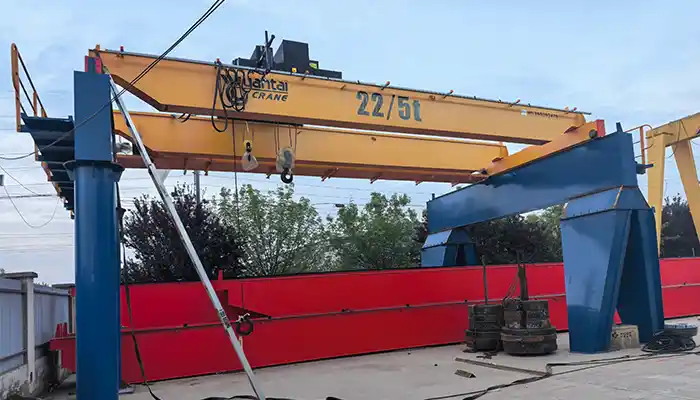
22/5 Ton Overhead Crane Double Hook System: Robust double girder crane with 22-ton main and 5-ton auxiliary hooks for heavy lifting. Get double hook crane!
Free consultation to Confirm Parameters & Specifications and Get
Latest Crane Price & Crane Rate.
- Types of overhead cranes : _______?
- Optional: Overhead travelling crane, goliath gantry crane,Slewing jib crane, Single girder or double girder crane,small portable crane or kbk crane, etc.
- Capacity of overhead crane: _______?
- Optional: 0.25ton, 0.5 ton, 1 ton, 2 ton, 3ton, 5 ton, 10 ton,15ton, 20ton, 25 ton, 30ton,35ton, up to 550ton, etc.
- Crane span & lifting height : _______?
- Crane travelling length : _____?
- Control of overhead crane:_______?
- Optional: pendant/ remote/cabin control
- Voltage supply of overhead crane:_____?
- Eg,: 380V50/60HZ,3Phase or others,etc.
- Application/usage of crane:_______?
- Eg,: Steel mill, ,injection mold, cement,stone, concrete,granite, general manufacturing, etc.
Just leave a message via the contact form and our hoist and crane engineer will contact you with in 24working hours.
Get In Touch
